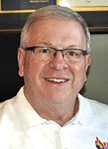Keeping It Safe | Robert Tutterow
This past March, I wrote about last year’s Wingspread Conference. In this column, I’ll do a deeper dive into the portions that are most applicable to the readers of this magazine.

The Wingspread Conference began in 1966 and was held every 10 years until recently. The Wingspread VII conference (most recent) was held five years after the 2016 Conference. The group had followed the logical conclusion that things are simply changing too fast for a 10-year gap to be beneficial. Hence, these conferences are now being held every five years. There were 37 participants (invitation only) in last year’s conference who represented a cross section of the fire service. The Conference gets its name from the location of most of the previous conferences—the Johnson Foundation’s Wingspread Conference Center in Racine, WI.
The report contains 12 statements of national significance to the U.S. fire and emergency services. Each statement has a brief description as well as a short background narrative.
The first statement relates to treating members and the public with “respect and dignity.” We have all heard too many stories about harassment, discrimination, hazing, and so on, within the fire service. A key quote from the report states, “To retain the public’s trust, we must prove that respect and dignity towards all customers, members, and stakeholders, both external and internal, is not optional.” Most fire departments are affiliated in some manner with government, and government has a negative connotation among many. The fire service must rise above the government stench and gain/maintain the public’s trust. We must do this 24 hours a day, 7 days a week, and regardless of whether we are on-duty or off-duty.
Of course, no group such as this could ignore the growing wildfire issue facing the nation and the world. Statement three underscores this issue by including the data in the background narrative. A key part of this statement is: “There is an overwhelming need to increase the support, technology, research, best practices, and resources to complete this mission.” There is also a need to share information with the global community about wildland fire suppression and prevention.
Almost all of the statements were alluded to or directly stated in the fourth statement of significance, which says, “Fire and emergency services should be recognized as part of the national critical infrastructure. As the fire service has become the all-hazards emergency response entity, the resources to staff and equip fire and emergency services has failed to meet these needs.” From this statement is the following: “Local communities must provide fire and emergency services with the needed resources to answer these and other emergent community expectations.” No guidance was provided as to how this must be accomplished. But the underlying theme when seeking additional resources are the two words “critical infrastructure.”
It is also important to note that statement five stresses the importance of fire and emergency services to expand their nonemergency medical care. This will perhaps require that, when recruiting new members, they must understand that the term “firefighter” is somewhat a misnomer as our service delivery continues to transform to the all-hazards (including hazard prevention) response agency.
Somewhat related to the first statement is statement seven, which identifies a new and growing concern. This statement pertains to the ability of the fire and emergency services to “recruit, retain, and train a qualified and diverse workforce.” Almost every organization is struggling to get a diverse workforce. As these two statements strongly emphasize, we can no longer be a profession that is overwhelmingly white males. The report states: “Additional resources, data, and research are required to overcome these challenges.”
Statement 10 is about the need for additional research to bring about new and improved technologies with an emphasis on emergency responder health and safety. There is a need to work with other industries such as the Department of Defense in technology transfer. As the report so aptly states, “Fire and emergency services equipment and apparatus should incorporate best-in-class, cost-effective, and interoperable technology to create an environment that promotes personnel health and safety and improves operational effectiveness for the community.”
Self-Monitoring, Analysis, and Reporting Technology (SMART) was emphasized in statement 11. The rapidly emerging technologies offer the ability to interface personnel with buildings and vehicles to provide real-time mission-critical information. As the report so succinctly states: “The challenges of implementing SMART technology are legal, social, financial, political, ethical, and cultural. Fire and emergency services organizations must recognize, understand, and have the necessary funding to utilize these technologies.”
To see the entire report, visit the Web site http://www.wingspreadvii.org. It is available to everyone free of charge.
ROBERT TUTTEROW retired as safety coordinator for the Charlotte (NC) Fire Department and is a member of the Fire Apparatus & Emergency Equipment Editorial Advisory Board. His 44-year career includes 10 as a volunteer. He has been very active in the National Fire Protection Association through service on the Fire Service Section Executive Board and technical committees involved with safety, apparatus, and personal protective equipment. He is a founding member and president of the Fire Industry Education Resource Organization (F.I.E.R.O.).

